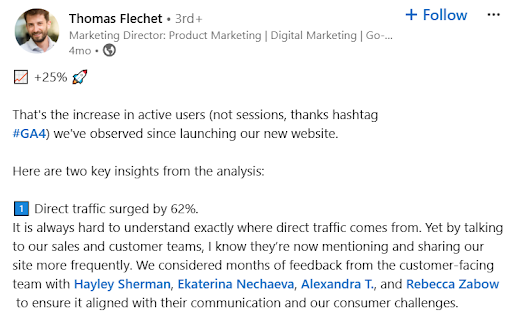7 hidden direct traffic tactics marketers often miss
You've just checked your analytics, and your organic traffic is dropping– again. Despite your best SEO efforts, Google’s latest update is pushing your content further down the page.
Numbers don't lie. Google reduced organic listings on 18.3% of SERPs, according to a recent analysis by Moz. Your carefully crafted content is fighting for limited visibility, and your impenetrable SEO strategy might not be enough anymore.
But what if you could bypass this battle entirely? Enter direct traffic.
Why should you care? Because direct traffic:
Bypasses search engines entirely, giving you control over the customer journey.
Represents brand-aware visitors who often already know and trust you.
Signals brand strength and loyalty, key markers for long-term success.
If you’re ready to grow your direct traffic and attract visitors who truly matter, let’s explore the tactics you’ve been overlooking.
Table of contents
3. Direct traffic vs. organic traffic: where should you focus?
4. 7 direct traffic tactics that actually work
5. How to measure and analyze direct traffic
6. Conclusion
What is direct traffic?
Direct traffic can be a bit tricky to define because people interpret it differently. Some say it refers to all website visits that can’t be traced to a specific source. Google Analytics defines it as visits with “no information about the referral source.”
Source: Google
But for this article, let’s stick to a simpler definition:
Direct traffic is when people find you by typing your URL or using links from social profiles.
The focus here is on something more specific: intentional visits from people seeking out your brand.
Think about how you log into Facebook. Do you Google it every time? Probably not. You type in the URL or use an app. That’s direct traffic in action.
This matters because organic reach is shrinking. Between AI-driven search results and paid ads, Google’s ecosystem is more crowded than ever. Direct traffic lets you sidestep all of that, creating a reliable relationship with your audience.
Why direct traffic matters
Here’s the problem: many marketers dismiss direct traffic because it’s harder to track. You can’t always pinpoint where it’s coming from, and that makes it feel less “valuable.” But let’s flip the script with a scenario you might recognize.
You're shopping for a high-ticket item, let's say a $2,000 laptop. Do you immediately buy from the first site you visit? Probably not. You research, compare options, and return directly to the sites you trust. It takes around eight interactions before prospects buy.
First visit: Google search (organic)
Second visit: Direct bookmark after reading reviews
Third visit: Direct type-in to check pricing
Fourth visit: Email link click
Fifth through seventh visits: Direct URL
Final visit: Direct conversion
Example of customer interaction with 6 touch points
This behavior pattern is exactly why direct traffic matters. In Google Analytics, only the final conversion gets attributed to direct traffic. However, those direct return visits were crucial in building trust and driving sales.
Websites that attract a greater share of their visitors through direct means tend to report better performance in terms of conversions. Why? Because these visitors already know your brand and trust your offering.
As Marketing Strategist, Taki Moore puts it below, sometimes you’re better off optimizing for conversations, not just conversions.
Source: LinkedIn
The relationship matters more than the initial click.
Direct traffic vs. organic traffic: where should you focus?
Before we get into tactics, let’s clarify the difference between direct and organic traffic:
Organic traffic: Comes from SEO efforts. People search for keywords, see your website, and click. It’s often top-of-funnel, bringing in new visitors.
Direct traffic: Reflects brand recognition. People already know about you and seek you out directly. It’s bottom-of-funnel, making visitors more likely to convert.
So, which should you focus on? Both are important, but direct traffic deserves more attention.
Here’s the challenge with organic traffic:
Almost one-fifth of tracked SERPs had reduced organic listings.
It’s heavily dependent on search engine algorithms, which change frequently.
On the other hand, direct traffic isn’t at Google’s mercy. It reflects your brand’s offline marketing efforts, customer loyalty, and awareness. It’s your safety net outside the search engine game.
7 direct traffic tactics that actually work
1. Align with customer-facing teams
Your sales, customer support, and marketing teams need to work together to create a unified customer experience. Why? Because these teams are your front line. They’re interacting directly with customers, solving problems, and answering questions.
💡 Find out: How to create content for every stage of the buyer journey
A B2B software company saw a 62% increase in direct traffic simply by aligning their marketing with customer support teams. How? They created dedicated landing pages for common customer questions and trained support staff to share these resources during conversations.
Source: LinkedIn
Implementation tips:
Create resource libraries based on frequent customer questions.
Develop easy-to-remember URLs for key pages.
Train customer-facing teams on when and how to share resources.
Track referrals from support interactions.
2. Build a strong social presence (the right way)
More than posting content, social media can be about creating a memorable presence that drives direct visits. Look at Slack's playbook. While their engaging content and responsive support are impressive, their traffic acquisition tactic is much simpler: slack-status.com.
Slack's X bio with direct link to website
By promoting this easy-to-remember URL across their social channels, they've trained users to skip Google and come directly to them. It's genius really— when users check the status page, they're just one click away from Slack's other offerings.
This creates a cycle of direct visits that starts with problem-solving but often ends in deeper engagement with their platform.
To replicate this success:
Focus on value-first content that solves real problems.
Create a consistent brand voice that stands out.
Make your handles and URLs memorable and easy to type.
Build communities around your content.
3. Prioritize technical SEO for retention
53% of mobile users abandon sites that take longer than three seconds to load. But speed isn't just about preventing abandonment; you also need to focus on encouraging return visits.
Source: Google
If visitors arrive on a slow or glitchy site, they won’t come back. Tools like Core Web Vitals can help you optimize speed, interactivity, and stability.
Key focus areas:
Run a technical audit to ensure your site loads
Optimize load times across all devices
Ensure mobile-first design
Create intuitive navigation paths
Implement effective site search
4. Bridge online and offline marketing
Don’t underestimate the power of offline efforts. QR codes on print ads, direct mail campaigns, and even branded swag can bring people directly to your site. The key is making the journey seamless and memorable.
Action step: Add QR codes to your offline campaigns that lead to specific landing pages.
5. Build your own platform
Creating your own platform = building a destination. HubSpot's Website Grader is a perfect example.
Source: HubSpot
Website Grader's monthly traffic data
Why this tactic worked:
Memorable URL— website.grader.com
Creates value while building brand recognition
Encourages repeat visits
Unsurprisingly, the brand confirms the website grader has been its most successful lead generation magnet. The free tool drives around 10,000 visits monthly.
6. Optimize for word-of-mouth referrals
Word-of-mouth is the original direct traffic driver. Research by Nielsen shows that 92% of consumers trust recommendations from people they know above all other forms of advertising. You can engineer digital word-of-mouth through:
Creating shareable content experiences
Developing employee advocacy programs
Building referral systems
Making content easy to share and reference
Your best advocates are your customers. Encourage them to share your URL in conversations, emails, and social posts. Word-of-mouth referrals are some of the highest-quality traffic you can get.
Action step: Make it easy for customers to share your site by creating shareable links and resources.
7. Implement cross-channel integration
Companies with strong cross-channel integration see a 91% higher year-over-year increase in customer retention rate than those without. Here is an example of how to combine channels effectively:
1. Email newsletters with bookmark-worthy resource libraries
2. Podcast episodes with memorable landing pages
3. Social content hubs with direct access links
Example of cross-channel integration
How to measure and analyze direct traffic
Before celebrating traffic increases, analyze the right kind of visitors. Why? Because up to 40% of all internet traffic is bots, not real people who want to engage with your content or buy your product.
Google Analytics 4 dashboard showing key direct traffic metrics
Start by using tools like Google Analytics GA4 to dig deeper into your data. Segment your direct traffic by:
Device: Are mobile users bouncing more than desktop users?
Geography: Does your traffic spike in unexpected regions?
Behavior: High bounce rates or unusually short session durations could indicate low-quality traffic or bots.
To weed out bot traffic, look for patterns:
Visits coming from a single IP address or location.
A 100% bounce rate paired with zero engagement.
Extremely short session durations.
But even real traffic has its challenges. 92% of consumers visiting a retailer’s website for the first time aren’t there to buy. This means you need to measure not just how much traffic you’re getting but how engaged and ready to convert your visitors are.
Consider marketing expert Victor Eduoh's case study with HoneyCart. They initially chased traffic through paid ads, getting plenty of visitors but "bouncing off their website as water bounces off hard rocks."
Only when they focused on quality over quantity did they see real results - a 900% increase in organic impressions and a 450% boost in organic clicks that actually converted.
Source: LinkedIn
The moral of the story is this: don’t chase traffic volume alone, chase traffic that matters.
Conclusion
Direct traffic isn’t just a metric to glance at in your reports. It reflects your brand’s strength, trust, and loyalty. While many marketers prefer to attribute conversions to specific campaigns, remember that direct traffic often plays a significant role in the buyer’s journey.
This isn’t about choosing direct traffic over other channels. You’ll be optimizing for all of them. By implementing these tactics, you grow your direct traffic and build lasting relationships with visitors who choose you first.
So, the next time you see a spike in direct traffic, don’t dismiss it. Embrace it as a win—because it is.
Love the tips shared in this article? Visit our blog to find hacks and inspiring stories of how successful marketers are setting their brands apart!
Also subscribe to our newsletter and join our community for updates, marketing trends, and growth opportunities











